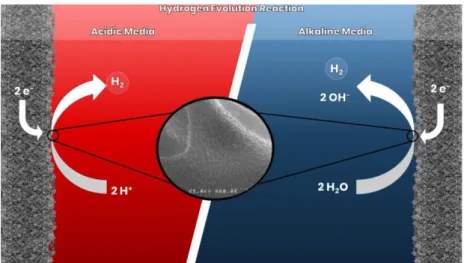Electrolysis & Fuel Cell Discussions
Towards Catalysts Free of Critical Raw Material for Fuel Cells & Elecrolysers15-18 September 2019, La Grande Motte, France
Efficient and Raw Material Free HER Catalysts Based on Doped ZIF Structures in Strong Acidic and
Basic Conditions and Improvement with Co
2Mo
3O
8Nanostructures
R. Dürr a*, F. El Orf a, R. Cornuta, B. Jousselmea, L. Hammarströmb
a Laboratory of Innovation in Surface Chemistry and Nanosciences (LICSEN), NIMBE, IRAMIS, CEA, CNRS, Université Paris-Saclay, CEA Paris-Saclay, 91191 Gif-sur-Yvette Cedex, France
b Department of Chemistry – Ångström Laboratory, Physical Chemistry, Uppsala University, Box 523, 751 20 Uppsala, Sweden
* Corresponding author email address: robin.duerr@escaled-project.eu
One of the most challenging issues in the 21st century is the global energy crisis and the connected climate change.
A way to target both problems is to use alternative energy source to fossil fuel like hydrogen as energy carrier. A green and carbon neutral way of producing hydrogen is water splitting with renewable energies like solar. However, generating hydrogen through electrochemical water splitting is unattractive, due to the high process costs compared with steam reforming. To lower the cost of the electrochemical water splitting it is crucial to work on alternatives for the rare and expensive platinum hydrogen evolution reaction (HER) catalyst. As part of the eSCALED project, which aims to develop an artificial leaf, this work is focused on the electrochemical hydrogen evolution with inexpensive and efficient earth abundant metals as catalysts. In this work, we present nanoparticles catalysts based on a highly porous zeolitic imidazolate framework (ZIF). The ZIF-8 structures were doped with earth abundant metals (Mn, Mg, Co, Ni and Fe). Some ZIFs were further improved with Co2Mo3O8 nanostructures to combine the high porosity and electrical conductivity of carbonized ZIFs with the outstanding catalytic activity of Co2Mo3O8 [1].
Both, ZIFs and Co2Mo3O8 nanoparticles weretested in pH 0 as well as in pH 14 at room temperature in different
configurations.
Figure 1: Hydrogen evolution in acidic and alkaline media. REFERENCES
